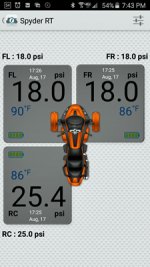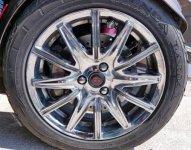Another little follow up video I did.
Bob
You're right Bob, many people don't know what their tire pressures are doing as the tire heats up, but it is just a tad more confusing than you think!! And your advice towards the end of that link above will do exactly the OPPOSITE of what you intended!

pps: Sorry.
The more your tire pressure is too LOW for what you are doing/asking of it, the greater the heat increase & therefore the MORE the pressure increase as you go!! It all comes back to the flexing of the tire carcass & the way the air inside it gets heated & expands when that happens - more flexing (say from lower tire pressures) and the hotter things get, so the greater the pressure increase! So if you want to make sure your tire pressure doesn't go up too high, you hafta ADD air pressure, not start lower, that'll only make your tires hotter & more likely to blow!!
Tire pressures & temperatures are definitely not as simple a thing as many believe, but it is something that can impact on things like tire wear & longevity, traction, handling, ride, and just about anything else you can imagine. But leaving out all the complexities & confusing that discussion would bring, at its simplest, for the 'optimum' balance between all those, you really want your tire temperature to increase by about 4-5 Degrees C and no more from what it is when cold, before you start riding - and funnily enough, that works out at being a pressure increase of about 4 PSI once your tires are up to temp. So to get the 'best' from your tire, especially if you are running automotive tires, you want to aim at a 'cold start' pressure that will give you a 4 psi increase after an hours ride. Most manufacturers of cars & tires, as well as drivers and owners, racers, tire techs, etc, have used what's become known as 'The 4 psi Rule' to help with this - Cooper Tires even put out a guide explaining this 'rule of thumb' for 4Wheelers, the 'Cooper Tires 4WD Drivers Guide', altho they do suggest using it only on road, but it applies anywhere, on or off road, just as much as it applies to the tire pressures you use for your cage & your bike as well as their 4WD's.
There's a helluva lot of discussion around about this little 'rule of thumb', altho in recent years most of it has been generated by 4WD Forums, but it will help you & anyone else who wants to bother with it to try and get the best from your tires; and once you understand how it all works & applies to what is happening in & to your tires, you can get more from them and your TPMS too, as well as making better educated decisions about how to prioritise one aspect of your ride or tire use to suit you/your needs (just like you have by choosing 19 psi for your front tires for the handling, altho that might come at a little cost in terms of tire life or ride/traction) Just stick '
the 4psi rule' into google & start reading. I apologise in advance for the seemingly blatant advertising (you'll see) but all that info (& typing) is already out there so why not use it, & besides, I'm retired now!

Sorry about out the epic read.

pps:


